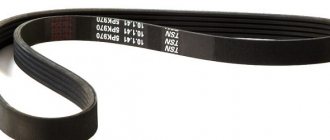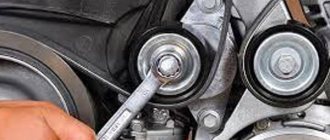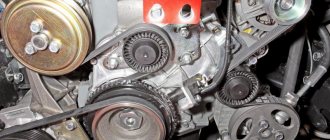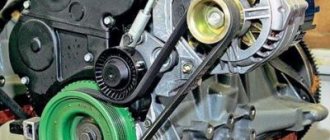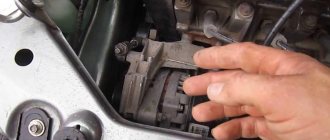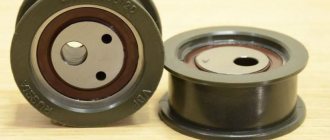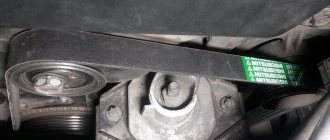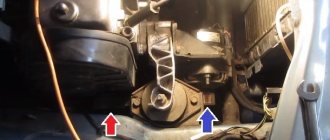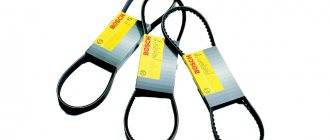As you know, in the engine compartment of a car, in addition to the internal combustion engine, there are also attachments. On the simplest cars, such equipment is a generator, while on modern cars, power steering, an air conditioning compressor, etc. are additionally installed.
One way or another, during the operation of the vehicle, you may encounter the alternator belt whistling, it often happens that the alternator drive belt creaks, etc. In this case, belt whistling can occur both constantly and at the moment of starting the internal combustion engine, in cold, wet weather, etc.
In any case, it is important to know why the generator whistles, since this sign clearly indicates certain problems. Next, we will look at the reasons why the alternator belt whistles, as well as what to do if the driver notices the generator whistling.
What can cause a whistling alternator belt?
Every driver who has at least 2-3 years of driving experience can determine the malfunction of his car not only by sight (when something has already fallen off) but also by hearing, when suddenly, quite unexpectedly, the car begins to make strange and frightening sounds. The most common such phenomenon will be the sound when the alternator belt whistles. And such “whistling music” cannot be confused with anything.
But if you catch such a sound, then rest assured that it will haunt you whenever you start the engine when it’s cold. Until you fix this problem. Sometimes car enthusiasts believe that eliminating this sound is quite simple. You just need to replace the old belt with a new one and the cause of the whistle will be eliminated. But this can only be partially said. It’s better, of course, to figure out why the alternator belt is whistling. This article will help you with this.
Low elasticity, contamination and liquid ingress
For the alternator belt to operate correctly and as efficiently as possible, it must be absolutely clean. The presence of dirt balls puts a lot of stress on the belt when it prevents it from moving evenly and maintaining tension. If during inspection a build-up of dirt and dust was found, you can risk cleaning the tape yourself. Perhaps using gasoline or additional means. If it was not possible to clean the belt, the consumable will have to be replaced.
A similar scheme operates if liquid is detected on the belt. Most often, to continue proper operation, it is enough to remove drops of moisture or technical substances from the surface of the belt.
The opposite situation occurs due to constant or regular exposure to car shampoos, water, detergents and chemicals. Constantly in contact with the polymer structure of the belt, they dry out and contribute to cracking of its surface. To protect the operating process of the car, the alternator belt can be treated with a protective liquid. Its task is to maintain the elastic properties of the material and improve its performance.
It is best to resort to this measure for preventive purposes in order to increase the resource of the element by 1.5–2 times. Such products are produced in the form of an aerosol.
So, where to start diagnosing if a whistle appears?
There can’t be two opinions here: the generator belt whistled, look for the reason in the generator itself. And in order to identify the source of the whistle, you must first find out the cause of this phenomenon. It could be:
- The belt is too worn
- The quality of the material does not meet GOST standards,
- The belt is heavily soiled or has oil stains.
But these may not be all the reasons why the alternator belt may whistle. In addition, it is advisable to check those parts that work together with the generator. This includes bearings and the mechanism responsible for belt tension,
To start diagnostics:
- Open the hood of the car.
- Find the alternator belt and visually inspect it.
- There should be no large cracks on the belt.
- It shouldn't look too worn out.
- Must have sufficient tension. Particular attention should be paid to this, since if the belt is loosely tensioned, this may be one of the main reasons why the belt whistles.
- Please ensure that all contacting parts are clean and dry and free of oil and other liquids.
If during a visual inspection you determine that the belt is very worn, then it is better to replace the belt. When buying a new belt, it is better to buy the original rather than chase a cheap Chinese fake. In this case, there is no point in saving, otherwise the whistling may happen again. If the accompanying parts (pulleys and flywheels) are dirty, this will not allow the belt to have normal tension. In this case, there is no need to change them - just wipe the dirty parts with a rag and clean them from dirt.
But sometimes it happens that during the first diagnosis it is not possible to determine why the alternator belt is whistling. But this does not mean that the reason is hidden elsewhere. It happens that a belt that has great rigidity will not be able to rotate well on the pulley. This happens when it's too cold outside and you're trying to start the engine.
In such cases, due to the low temperature conditions, the belt will become hard and this may slow down its rotation. In this case, the whistle may appear when you start the engine when it is cold, but it will gradually disappear as the engine warms up. Some cars have a special tension pulley. Therefore, during diagnosis, pay special attention to it. Primarily on wear of the bearings, which can also lead to an unpleasant sound. And often it is enough to replace this video and the sound will disappear.
Why does the belt whistle when cold?
The problem of whistling when cold can have several varieties. A squeak or whistle does not appear when the engine starts, but after a couple of minutes. This problem is easily diagnosed, since after the engine reaches operating temperature, the sound disappears.
The reason for the non-standard behavior of the belt is also hidden in its slippage. The torque transmitted from the crankshaft is not sufficient to spin the pulley. There are several reasons for this problem:
- Inaccurate selection of bearing lubricant for the generator. Due to the compaction of the lubricating fluid consistency at low temperatures outside, the generator pulley is not able to function as usual until the machine’s power unit warms up. At engine operating temperature, the lubricant will defrost and the unpleasant sound will disappear. The solution to the problem will be for the car owner to purchase a lubricant option that is more resistant to temperature changes outside the window.
- Weak tension. This situation is identical to the previous one. Until the engine reaches the required operating temperature, due to low tension, the belt is not able to perform its functions at the required speed and will slip.
How to tighten a belt so that the whistling stops
Let's say that during a visual inspection you have determined that the alternator belt was not caused by external influences. The belt has no cracks, is not frayed, etc. What to do in this case? And here we need to take into account the mechanical effect on the belt. First, you need to assess the condition of the belt tensioner, which is responsible for tensioning the generator belt. This indicator for each specific car can be found in the registration certificate for the car. If the tension is below the desired value, then you need to try re-tensioning the belt. But if this fails, it is necessary to replace the generator belt tensioner roller.
Any car owner should know that belt tension is the main component of the correct operation of the generator, and the service life of the battery, water pump and other mechanisms will depend on this. Because if the generator belt has a deflection, this will significantly reduce the efficiency of the generator, and, as a result, the charging current of the required power will not be generated.
In addition to this, a loosely tensioned belt wears out faster and can break, and this will lead to very disastrous consequences. But do not tighten the belt too much - the bearings may fail. In other words, there must be a “golden mean” in everything and the alternator belt must be tensioned in accordance with the technical parameters recommended by the manufacturer.
For example, on domestically produced cars, the slack of the alternator belt should be no more than 15 mm if a force of 10/kg.cm is applied. It’s not difficult to check this parameter (if you have a domestic car). Take a strip of metal up to forty centimeters long and place it on the crankshaft and generator pulley. Then press the belt with the required force and measure the resulting deflection with a tape measure. If the resulting result differs from the desired value, then adjust the belt tension. And if this fails, then the belt needs to be changed.
But there is no need to rush into this. Since the cause of an unpleasant whistle, as well as weak tension in the alternator belt, can be the belt tensioner itself. It may have significant wear, which will not allow the belt to be tensioned to the desired value. To make sure that the tensioner pulley is working properly, you need to remove the alternator belt and check if there is any play in the tensioner. If there is no play, then everything is fine with the part, but if there is play, then the part needs to be replaced.
Be sure to check the tension roller for noise during rotation and the integrity of its bearings. It would also be a good idea to check the pulleys and bearings for curvature relative to the direction of rotation of the generator belt. If they are deviated to the side, they need to be adjusted.
Briefly about the hanging belt
Belt drive is the most common method of transmitting rotation to the generator rotor. The method has been used for a long time and differs from others in its simplicity: only two pulleys on shafts that are connected by a belt.
The belt itself is responsible for a lot. It is he who is responsible for transmitting rotation from pulley to pulley. You should be aware that one part of the belt is tighter than the other . It is the difference between these tensions that determines the traction force and its coefficient.
The belt provides precise transmission and is quiet in operation. High-quality products are able to withstand long-term loads, smooth out shocks and jerks. They are compact, take up little space, but simultaneously operate several important components of the car: generator, pump, air conditioning compressor and power steering pump.
The generator rotor must rotate constantly. This is facilitated by the belt connection to the crankshaft. The pulleys, which are screwed onto the generator and crankshaft shafts, are connected by a belt, which must be flexible.
The “whistle” of the belt is similar to a disgusting clang. It is caused by the belt slipping. The sound of such a whistle is unpleasant and can be heard at a great distance. Of course, you should not drive in such a situation.
Replace or tighten
Some people don’t want to spend money on a kit, and they hope to get by with a timing belt tightening. If it is not worn out and was indeed tensioned incorrectly to begin with or has become loose later, this may solve the problem.
But pulling up will only help if the problem is not with the support roller. If the latter is skewed, the whistle may even intensify when the pressure becomes even greater.
In this case, tightening should only be used to prevent the timing belt from being too loose, to prevent it from jumping one or more teeth. After a temporary measure, you should visit a service station as soon as possible.
Uneven pulley line
The next reason for belt whistling is misalignment of the pulleys. For proper operation, the generator pulleys and engine shafts must be in line.
To diagnose the problem, you need to use a ruler to measure the level of the pulleys. Elements are considered coaxial only if there are no gaps between the surface of the ruler and the pulleys. This problem can be corrected by eliminating the deformation of the fastening of the hinged part using straightening or simply replacing the pulley.
If it is not possible to check the alignment due to a non-standard front surface or fastening, then the pulleys must be unscrewed. It is necessary to stretch a thread or string between the flanges. Next, we apply a ruler to the flange and, if the elements are parallel, the two pulleys are on the same axis.
Why does it fly off?
Before talking about whistles, you need to figure out why it might simply slip off the pulleys. So:
- The generator itself is jammed . It happens that the bearings get stuck and the armature simply does not rotate. Then it will fly off or break in a few seconds; this has happened to me more than once in practice.
- Oil or diesel is leaking . It rarely happens from gasoline, but it is not as oily as diesel fuel. But if diesel gets on the “canvas” (no matter what kind, ATF or engine), then it begins to “absorb” and, as the experts say, “grow” in size. Often it becomes wide and gets out of engagement with the teeth of the generator pulley, and then flies off. In practice, I had such a case when they changed the oil themselves, the filter was not screwed on tightly and engine oil pressed out from under it, and threw the generator and belt. After some time, everyone noticed this, but the belt drive was already almost flying off, it was sitting on the wrong teeth, and also its sidewall was worn out - we had to change it, tighten the filter. We also had to remove the generating unit itself and wash it, because oil was oozing from it and spreading all over the engine compartment
- Weak tension . But here he will whistle like crazy, more on that below
- The time has come, wear and tear . Well, and of course, the last thing is the wear and tear of the belt itself, it happens that it has already “dried out”, cracked from time to time and can no longer hold its shape. There is only a replacement, and the sooner the better.
Belt wear and other reasons
In addition to the most common reasons, unpleasant sounds from under the hood can also be caused by problems with bearings, couplings or pulleys. Replacing the problematic part and timely technical inspection in the future will help correct the situation.
If you miss a scheduled replacement of the alternator belt, the risk of stalling in the middle of the road will increase every day. The belt may lose its elastic properties, crack or break. This process will be accelerated by poor quality tape.
To avoid problems with the drive belt and effectively eliminate the consequences of problems, it is better to find out more about the problem in advance. Visual videos will help with this:
As it was before?
Previously, on cars, the belt drove only one unit - the generator, which simplified the establishment of the cause of the sound (there are only two options - the belt itself or the generator).
With the improvement of power plants, the amount of equipment that is driven by the generator belt has increased and it has already begun to be called an attachment drive.
It is now considered common practice that a flexible transmission simultaneously rotates 3-5 units, not counting the auxiliary elements - bypass and tension rollers, although there are cars in which the element is driven only by a generator, for example, a Lada Priora without air conditioning.
But on the Ford Focus 2, the belt drives the generator, power steering pump and water pump (cooling system pump).
On Reno Logan, the number of driven attachments depends on the configuration - in the simplest version, the belt drives only the generator, on models with power steering the element already “turns” the amplifier pump, and in cars equipped with air conditioning, the drive also turns the climate compressor -systems.
If we take the Hyundai Tucson, then in this crossover the task of the belt already includes driving the generator, power steering pumps and cooling system, as well as the air conditioning compressor.

